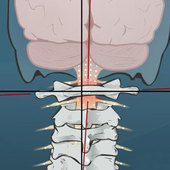
Does it sometimes hurt to be around bright lights or loud noises? Does your head pound when you have a migraine headache?
According to Statistics Canada, an estimated 8.3% of Canadians (2.7 million people) reported that they had been diagnosed with migraine.
Throbbing pain, nausea, an inability to keep your eyes open – these are the symptoms of even a mild migraine. Many migraine headache sufferers also commonly experience neck pain.
Though most take painkillers to begin alleviating symptoms, you may want to reach out to a migraine specialist to find a more permanent solution.
Before seeking treatment, it’s important to acquaint yourself with the connection between your neck and your brain. We often speak of our bodies in terms of completely separate systems, but in fact, each system works together in tandem to function properly. When one aspect is unbalanced, the rest are likely to be unbalanced as well.
Understanding the neck and brain relationship can help nail down what structural issue is at play behind your migraine.
Headache and Migraine Professional
Migraines are a pain in the neck!
A migraine often causes severe throbbing pain in the head. This can be accompanied by nausea, vomiting, and extreme sensitivity to light and sound. However, the symptoms that don’t get nearly enough attention are neck pain and neck stiffness.
According to a study done in 2010, neck pain was found to be one of the most common migraine symptoms, even more common than nausea.

How can this be so?
At the base of your brain sits the top of your spine, along with bundles of nerves. You can feel mild to intense pain throughout your entire body when your spine slips out of alignment in your upper or lower back.
So, neck pain is so prominent amongst migraineurs because of the effect an upper cervical misalignment has on the brain. When you have a migraine, spinal misalignment could be the culprit.

The neck and brain complex
When your first vertebrae, known as the atlas, slips out of place, the function of the entire central nervous system can be thrown off.This is because a misaligned atlas vertebrae can create a spinal cord distortion, potentially disrupting the communication between the brainstem and the body.
The first and second vertebrae, also known as the C1 and C2, make up the upper cervical spine. They both play crucial roles in:
- Protecting the spinal cord and brainstem
- Supporting the head
- Enabling blood flow to and from the brain
Misalignments in the upper neck can irritate nerves and even restrict the flow of fluids out of the head. When fluids aren’t draining from the head properly, there will be a buildup of pressure which can lead to a variety of problems, including headaches and migraines.

What can cause upper cervical misalignments?
Head or neck trauma can cause the vertebrae to slip out of place. Concussions are often overlooked as a cause of neck injury.
Other ways of sustaining neck injuries include whiplash from a car accident and/or a lifestyle that’s causing you to have an improper posture.
How to find the right migraine specialist for you
When suffering from migraines, it can be extremely tempting to rush for a quick fix or an intense treatment regimen. Be cautioned, it’s important to seek proper treatment. If the cause of your migraines is structural, such as a neck injury or an upper cervical misalignment, then incorrect treatments can cost you both time and money, as well as potentially make the symptoms worse.
The key to migraine relief will vary from person to person. Make sure to take the time to find the right treatment for you, and that the treatment will factor in any past injuries as well. There are a few important steps to take before seeking a migraine specialist:
- Seek out proper diagnosis
- Treat migraine attacks early
- Begin a preventative treatment plan
The most important part of finding the right migraine treatment lies in creating a preventative treatment plan with your health provider.
How NUCCA chiropractic can help to treat migraines
NUCCA chiropractic care is a treatment concerned specifically with the upper cervical spine. An upper cervical adjustment can work to balance and stabilize the neck, which leads to optimal communication between the brain and the body.
This correction both helps to treat and prevent migraine headaches.
NUCCA Care as part of your migraine treatment
NUCCA chiropractic focuses on returning the neck to its correct position in relation to the head. As the correction in the head and upper neck is achieved, postural adaptations within the entire body are brought back into balance and stress is reduced.
Because NUCCA care is very case-specific, our NUCCA chiropractors at The Vital Posture™ Clinic will run you through a proper analysis of your upper cervical misalignment. You will also get a chance to see the impact of any past neck injuries through advanced Digital X-Ray imaging.
NUCCA adjustments support self healing and aim to restore appropriate communication within the body. The average patient sees more than a 50% reduction in postural distortion within 2-3 days of the initial visit.
The correction made on your upper cervical spine can be a key component in facilitating migraine relief and the accompanying neck pain or stiffness.
NUCCA chiropractors can relieve your pain, rebalance your posture, rejuvenate your life. To learn about our how we treat patients with migraines, feel free to send your questions to our team.




